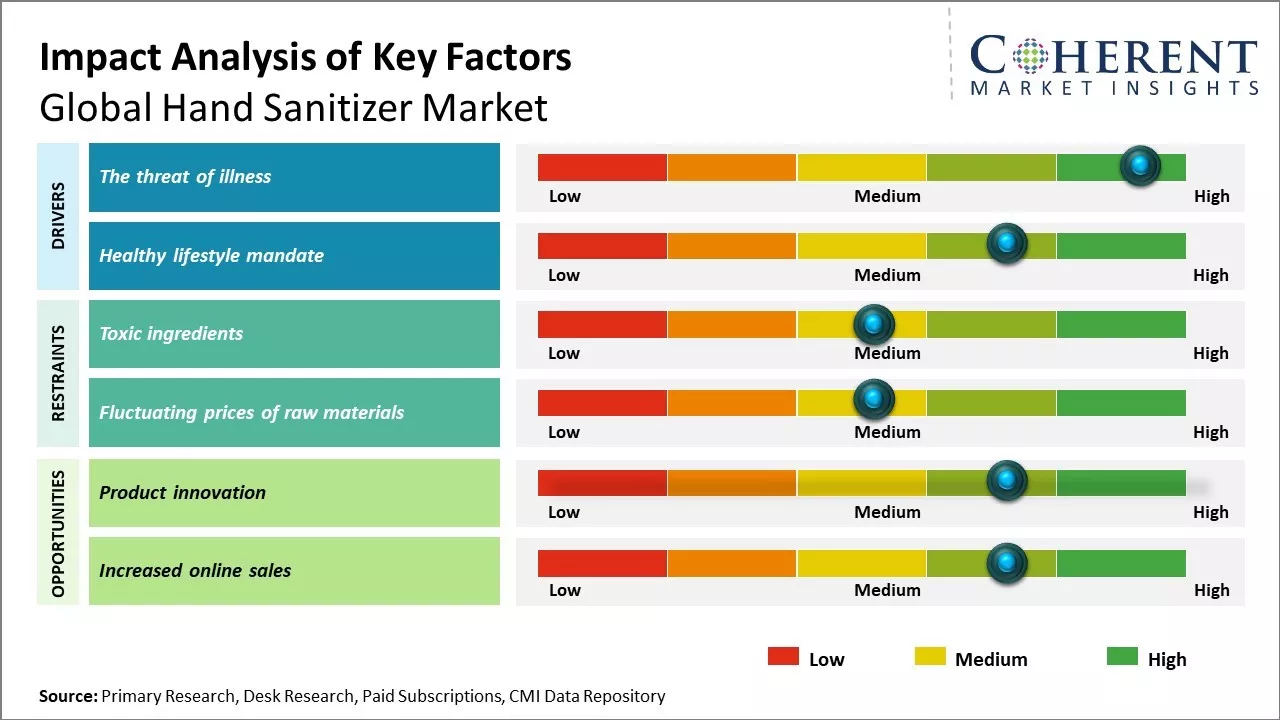The hand sanitizer market is estimated to be valued at USD 7.38 Bn in 2025 and is expected to reach USD 8.72 Bn by 2032, exhibiting a compound annual growth rate (CAGR) of 2.4% from 2025 to 2032.

To learn more about this report, Download Free Sample
The growing awareness regarding health and hygiene, along with rising consciousness to curb the spread of infections and diseases, is expected to drive hand sanitizer market demand during the forecast period. Widespread promotion of hand hygiene by healthcare agencies and governments, along with increasing adoption of hand hygiene practices in community and commercial spaces such as offices, schools, and malls, is augmenting demand. The rising need for frequent and proper hand disinfection to limit transmission of contagious illnesses further propels market growth. Additionally, the preference for handy packaging and availability of natural and alcohol-free products catering to specific consumer needs will continue supporting the market expansion
|
Current Event |
Description and its Impact |
|
Regulatory Tightening and Quality Control Enforcement |
|
|
Sustainability Transition and Environmental Compliance |
|
Uncover macros and micros vetted on 75+ parameters: Get instant access to report
Between May 2022 and April 2023, India exported 13 shipments of alcohol-based hand sanitizers, with no growth compared to the previous year. These exports were made to just two countries—Chile and Sri Lanka—by zero active Indian exporters, indicating either exit or inactivity in the sector. Globally, the United States led hand sanitizer exports with 302 shipments, followed by Costa Rica (94) and the Netherlands (60). In contrast, worldwide exports of hand sanitizers under HSN code 30049087 saw a 33% decline from January 2022 to December 2023, with only 4 shipments made by 2 exporters to 2 buyers, and no exports recorded in December 2023.
In terms of product type, the gel/liquid segment is expected to hold 87.7% of the global hand sanitizer market in 2025 due to its convenience and effectiveness. Gel sanitizers, with higher alcohol content, kill 99.9% of germs in 15 seconds without water, making them ideal for busy lifestyles. Their portable, easy-to-use bottles and quick-drying properties suit on-the-go use, while pleasant scents enhance user experience. Growing hygiene awareness from disease outbreaks further drives adoption among individuals and institutions such as hospitals and schools.
For instance, in March 2025, Miracle Brands, under Global Health Solutions (DBA Turn Therapeutics), introduced a new alcohol-free liquid hand sanitizer. Powered by benzalkonium chloride (0.13 g per 100 g), the spray effectively sanitizes hands, is safe for frequent use, and comes in a 4-fl-oz (118 mL) format.
In terms of distribution channel, the hypermarkets/supermarkets segment is expected to hold 40.3% of the hand sanitizer market in 2025. This is driven by expanding shelf space for feminine hygiene products, one-stop shopping convenience, and attractive pricing enabled by large-scale procurement. Dedicated displays increase visibility and encourage impulse purchases, while robust supply chains ensure consistent availability. These factors help hypermarkets drive mass-market acceptance and boost trials among new consumer segments.
For instance, in March 2025, Touchland, the cult-favorite hand sanitizer brand, expanded into fragrances with the launch of its Power Essence body and hair mists. Sephora, and Ulta for $20, the line features eight mood-evoking scents, like Lush Tropicale and Vanilla Velvet and skin-hydrating ingredients such as hyaluronic acid and niacinamide

To learn more about this report, Download Free Sample
North America has emerged as the largest market for hand sanitizers globally. The region is expected to account for 35.0% of the market share in 2025. The U.S. accounts for the bulk of the hand sanitizer market due to rise in health awareness among the population. There is a growing culture of hand hygiene in several settings including workplaces, schools and hospitals, thereby creating robust demand for hand sanitizers. The presence of leading manufacturers in the region, such as GOJO Industries and Reckitt Benckiser, provides ease of access to consumers. These players have established dominant positions due to their long presence and extensive distribution channels across retail stores, pharmacies, and online platforms. They offer a diverse range of products at varied price points to cater to various consumer segments. The strong foothold of local brands is a major factor that has enabled North America to gain global supremacy in the hand sanitizer domain.
For instance, in August 2025, SC Johnson Professional unveiled TruShot 2.0® No-Rinse Sanitizer, a fast and easy sanitizing solution requiring no mixing or rinsing. Designed for use on hard, non-porous, food-contact surfaces, the product simplifies sanitization with a mobile dispensing system and food-safe formula, streamlining hygiene procedures.
Asia Pacific has witnessed the fastest growth in the hand sanitizer segment in recent years. Countries like Indonesia and Vietnam have emerged as highly promising developing markets due to their improving economic conditions and rising focus on health and hygiene. The steady growth in urban population coupled with increasing consumer awareness about health issues like infections is driving demand. International players see significant potential in these populous nations and have intensified their advertising and branding activities. Local manufacturers are also coming up with affordable product lines targeting the cost-conscious segments, which has spurred overall market expansion. Stringent regulations regarding hand hygiene in public spaces, such as train stations, shopping malls and airports across Southeast Asian nations will further stimulate the consumption of hand sanitizers in the region over the coming years.
For instance, in August 2025, Indonesian startup SanGreat Natural Indonesia, co-founded by biotech specialist Fifin Nashirotun Nisya, has developed eco-friendly, non-toxic home-care solutions. The company’s expanding “Bye Bye” line, including pest repellents, biopesticides and even a hand sanitizer, prioritizes safety and sustainability using over 90% natural ingredients.
The U.S. leads global demand, supported by strong institutional requirements, strict hygiene regulations, and high consumer awareness. Extensive retail and e-commerce channels make sanitizers widely accessible across households, workplaces, and healthcare facilities.
For instance, in July 24, 2025, GOJO Industries unveiled its latest Purell innovation: an invigorating hand sanitizer spray claiming to be four times more effective than pricier mist products. Designed for on-the-go use, the new spray offers fast, refreshing germ protection and expands Purell’s consumer hand hygiene offerings.
China is the fastest-growing market, driven by government mandates for hygiene in public spaces, rapid urbanization, and strong e-commerce distribution. Growing adoption in both urban and rural areas further fuels demand.
For instance, in February 2025, INTCO Medical is strengthening its global manufacturing network with strategically located factories in Zhenjiang, China, and Quang Ninh, Vietnam. These facilities bolster supply chain efficiency, cost-effective production, rapid delivery, and flexible response to market needs. Notably, the company also produces hygiene essentials like hand sanitizer, addressing growing demand worldwide.

To learn more about this report, Download Free Sample
| Report Coverage | Details | ||
|---|---|---|---|
| Base Year: | 2024 | Market Size in 2025: | USD 7.38 Bn |
| Historical Data for: | 2020 To 2024 | Forecast Period: | 2025 To 2032 |
| Forecast Period 2025 to 2032 CAGR: | 2.4% | 2032 Value Projection: | USD 8.72 Bn |
| Geographies covered: |
|
||
| Segments covered: |
|
||
| Companies covered: |
Reckitt Benckiser Group plc, Procter and Gamble, The Himalaya Drug Company, GOJO Industries, Inc., Henkel AG and Company, Unilever, Vi-Jon, Chattem, Inc., Best Sanitizers, Inc., Kutol, Edgewell Personal Care, L Brands Inc., Unilever PLC, 3M Company, and Colgate-Palmolive Company |
||
| Growth Drivers: |
|
||
| Restraints & Challenges: |
|
||
Uncover macros and micros vetted on 75+ parameters: Get instant access to report
The persistent threat of illness is a key factor boosting the adoption of hand sanitizers globally. Consumers are increasingly aware that frequent hand disinfection is one of the most effective ways to prevent the spread of bacteria and viruses in daily life. This heightened focus on personal hygiene extends across homes, workplaces, schools, and public spaces, driving higher product consumption. As a result, manufacturers are expanding their product ranges with convenient packaging and specialized formulations to meet diverse consumer needs. These factors collectively contribute to the growth and expansion of the hand sanitizer market share, solidifying its role as an essential hygiene product worldwide.
Along with illness phobia, another significant driver has been the rising health consciousness worldwide. Preventive healthcare is receiving more attention than ever before. Lifestyle diseases causing millions of deaths each year are ringing serious alarm bells. Issues like diabetes, cardiac problems, obesity, etc. are not just limited to developed nations now but have become a pressing concern for developing ones as well. Their economic and social costs are immense. This realization is propelling individuals as well as governments to focus on building a preventive framework. Promoting habits like proper sanitization is an effective part of this approach.
People especially the young working professionals are now more mindful of their fitness and immunity levels. Adopting a disciplined personal care regimen forms an indispensable element of their healthy lifestyle goals.
Product innovation holds strong potential in the global hand sanitizer market. Rising consumer awareness around health and safety is pushing manufacturers to develop unique and value-added formulations. Innovations include portable, travel-friendly sanitizers in shapes like keychains or wrist straps for easy access and frequent use. Others enhance formulations with moisturizers to prevent skin dryness from repeated alcohol usage. Such advancements improve convenience and user experience, supporting growth in the hand sanitizer market forecast.
The hand sanitizer market is transitioning from basic hygiene utility to a value-driven category defined by premiumization, innovation, and sustainability.
From a hand sanitizer market value standpoint, products with natural extracts, moisturizers, or skin-friendly ingredients are priced 20–25% higher than standard options yet consistently achieve stronger consumer loyalty. This highlights a clear preference for formulations that merge efficacy with personal care benefits.
On the hand sanitizer market price side, bulk institutional packs are seeing stabilization, while designer variants retain a 30–35% premium. Brands like Bath & Body Works leverage seasonal scents and limited editions to sustain higher pricing power, while eco-friendly refills and portable formats further drive differentiation.
At the same time, commoditization pressures remain intense, with private labels undercutting established brands by up to 40%. Competing purely on cost is unsustainable, differentiation through brand equity and innovation is critical.
In essence, the market’s trajectory is shifting toward value creation over volume, where success hinges on balancing premium value and sustainable price positioning.
*Definition: The hand sanitizer market consists of companies that manufacture and sell hand sanitizing products to help reduce bacteria and germs on hands. Common hand sanitizers contain alcohol, usually in the form of ethyl alcohol or isopropyl alcohol, which work by killing many types of bacteria and viruses when applied to hands. Major players in the hand sanitizer market offer gel, foam, spray, and wipe formats for consumer and commercial use. During outbreaks of infectious diseases like COVID-19, the demand surges for these products as more individuals and organizations strive to increase hand hygiene practices for health protection.
Share
Share
About Author
Sakshi Suryawanshi is a Research Consultant with 6 years of extensive experience in market research and consulting. She is proficient in market estimation, competitive analysis, and patent analysis. Sakshi excels in identifying market trends and evaluating competitive landscapes to provide actionable insights that drive strategic decision-making. Her expertise helps businesses navigate complex market dynamics and achieve their objectives effectively.
Missing comfort of reading report in your local language? Find your preferred language :
Transform your Strategy with Exclusive Trending Reports :
Frequently Asked Questions
Joining thousands of companies around the world committed to making the Excellent Business Solutions.
View All Our Clients